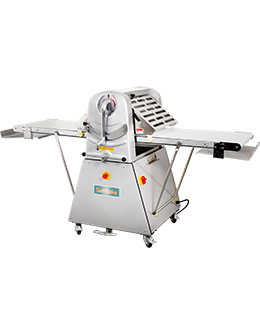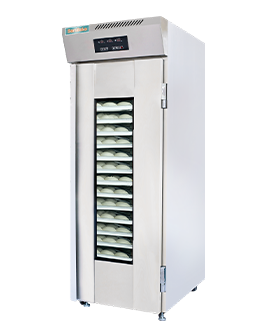Dough Moulder
Introduction to Dough Moulders

What is a Dough Moulder?
Why Do Bakers Use Moulders?
Manual vs. Automatic Moulders
How Dough Moulders Work
Feeding the Dough
You start by placing the pre-divided dough piece onto the infeed conveyor. The rollers do the magic from there.
Sheeting, Curling, and Rolling
The dough is sheeted—flattened into a uniform thickness—then curled into a tight roll, simulating what a baker would do with both hands.
Output and Shaping Styles
Adjust settings to get different shapes, from a baguette to a sandwich loaf. Some machines even let you fine-tune the tightness of the curl.
Types of Dough Moulders
Horizontal Dough Moulders
Ideal for longer loaves like baguettes. They lay flat and work well with gentle doughs.
Vertical Dough Moulders
Save space and are better for rounder, denser dough products. The dough moves upward through the rollers.
Compact and Floor Models
Countertop models fit tight kitchens. Floor models offer more power and are perfect for bakeries running high volumes daily.
Applications in Commercial and Artisan Bakeries
Standard Loaf Bread
Perfect for sandwich bread, white bread, or multigrain loaves.
Baguettes and Sub Rolls
Longer, thinner doughs benefit from the stretching ability of horizontal moulders.
Specialty Breads and Artisan Products
Even rustic-style loaves can start with a moulder and finish with hand scoring for an artisan look.
Benefits of Using a Dough Moulder
Consistent Shape and Texture
Get that uniform crust and crumb every single time—customers notice the difference.
Increased Production Efficiency
Speed up the production line without hiring extra hands. One operator can do the job of three.
Less Waste and Rework
No more oddly shaped or mis-sized dough pieces that you have to remake or discard.
Key Features to Look for in a Dough Moulder
Adjustable Rollers and Pressure Plates
Custom-fit your shaping process based on dough type and end product.
Speed and Dough Size Range
Choose machines that handle the range of dough weights and batch sizes you typically use.
Sanitary and Easy-to-Clean Design
Look for stainless steel parts and open-frame designs for easy cleaning.
Choosing the Right Dough Moulder for Your Bakery
Volume Needs and Production Scale
Are you baking 200 loaves a day—or 2,000? Scale matters when choosing your model.
Dough Types and Recipes
Sticky, soft, or dense—match your machine’s capabilities to your dough.
Space and Layout Considerations
Some bakeries don’t have room for floor models. Check dimensions before buying.
Setting Up and Using a Dough Moulder
Installation Basics
Most machines plug into standard power outlets and come semi-assembled. Always follow the manufacturer's guide.
Operating Tips for Best Results
Keep dough rested before moulding. Avoid overworking the gluten. Adjust settings slowly during your first runs.
Maintenance Guidelines
Clean daily. Inspect rollers and belts weekly. Lubricate moving parts monthly.
Dough Moulder Troubleshooting
Uneven Rolling or Flattening
Check for misaligned rollers or worn belts. Dough may also be too cold or too tight.
Dough Tearing or Jamming
Usually caused by over-floured dough or incorrect roller pressure. Reset and adjust accordingly.
Roller Misalignment
Use the manufacturer’s alignment guide to recalibrate. A small tweak can make a big difference.
Cost vs. Value: Is It Worth the Investment?
Comparing Manual Labor to Machine Efficiency
Manual shaping is time-consuming. One machine can do the work of multiple bakers—without needing a lunch break.
ROI Over Time
Most bakeries recoup the cost in 6–12 months via labor savings and increased production.
Top Dough Moulder Brands to Consider
Top Models for Small Bakeries
-
DoughTech Compact Moulder
-
Erika Record Artisan Series
Industry-Grade Machines for High Output
-
VMI Rollmatic
-
Sottoriva Industrial Moulder
Safety and Hygiene in Dough Moulding
Food-Grade Materials and Coatings
Look for FDA-compliant materials and non-stick coatings that are safe for food contact.
Safety Shields and Emergency Stops
Machines should include guards and panic stop buttons to prevent injury.
Dough Moulders vs. Hand Moulding
Pros and Cons of Each Method
Hand moulding gives an artisan feel but isn’t scalable. Machines offer speed, hygiene, and consistency.
When Hand Moulding Still Makes Sense
For small-batch or artistic loaves, hand moulding lets you add a personal touch.
Innovations in Dough Moulding Technology
Smart Sensors and Automation
Some moulders adjust pressure and speed based on dough characteristics in real time.
Energy-Efficient Motors
Look for machines that save on electricity—good for your bills and the environment.
Conclusion
Dough moulders are the unsung heroes in any bakery looking to scale with precision. They don’t just save time—they create consistently beautiful bread that sells. Whether you're running a boutique bakery or a full-scale bread factory, investing in a dough moulder might just be your smartest move yet.
FAQs
Can I mould different types of dough in the same machine?
Yes! Most machines are adjustable for a wide variety of dough types.
How often should a dough moulder be cleaned?
Daily cleaning is recommended to maintain hygiene and prolong the machine’s lifespan.
Is it beginner-friendly?
Many moulders come with intuitive controls. With a short learning curve, even new staff can operate them easily.
Will it work for gluten-free dough?
Yes, but choose a machine designed to handle delicate or sticky doughs.
Can it replace hand shaping completely?
For most products, yes. But artisan or custom loaves may still benefit from hand finishing.
- *Name
- *Title
- *Content
- Name:
- Vickey
- Tel:
+86-18862554041
- Email:
- sales@sambake.com
- Address:
- Xinxiang Industrial Park,Wuxi City,Jiangsu China







